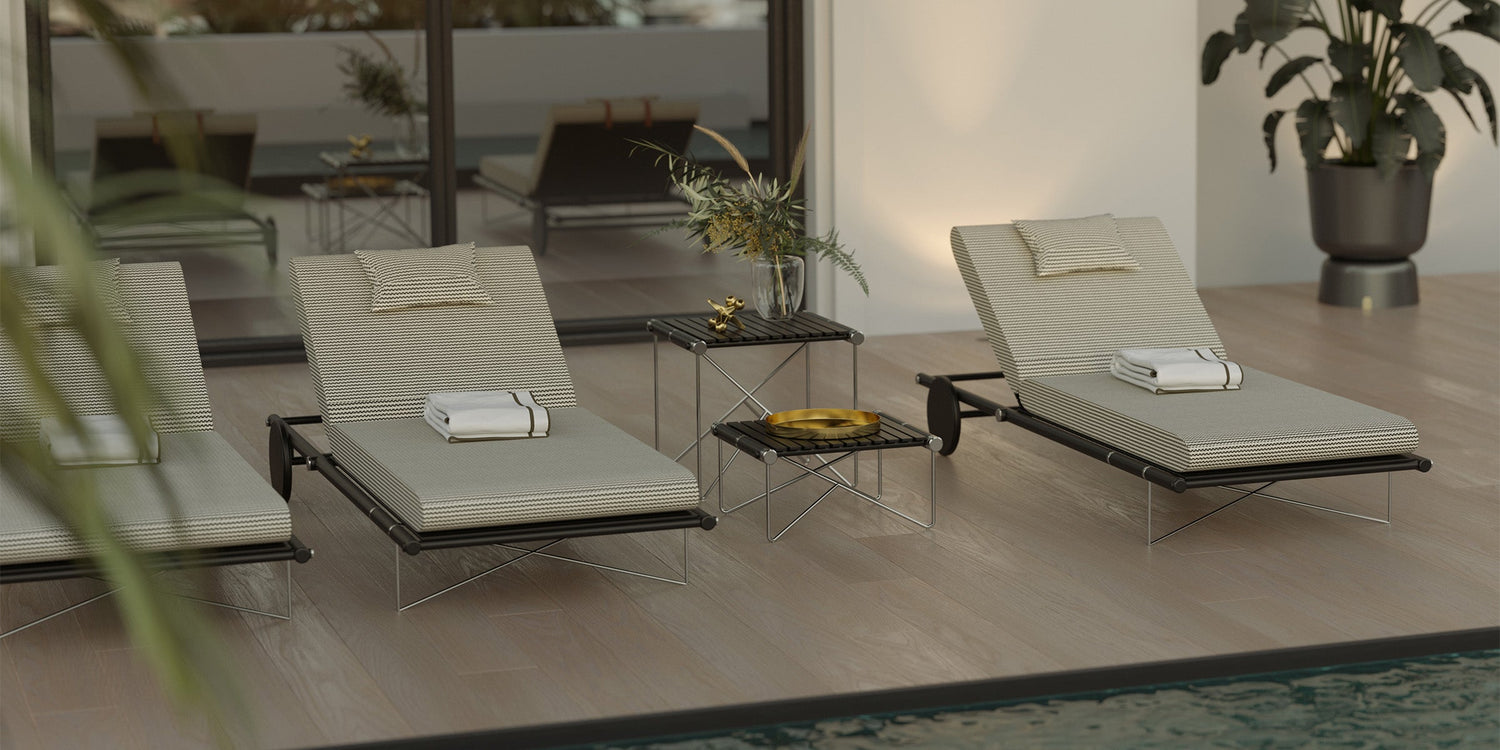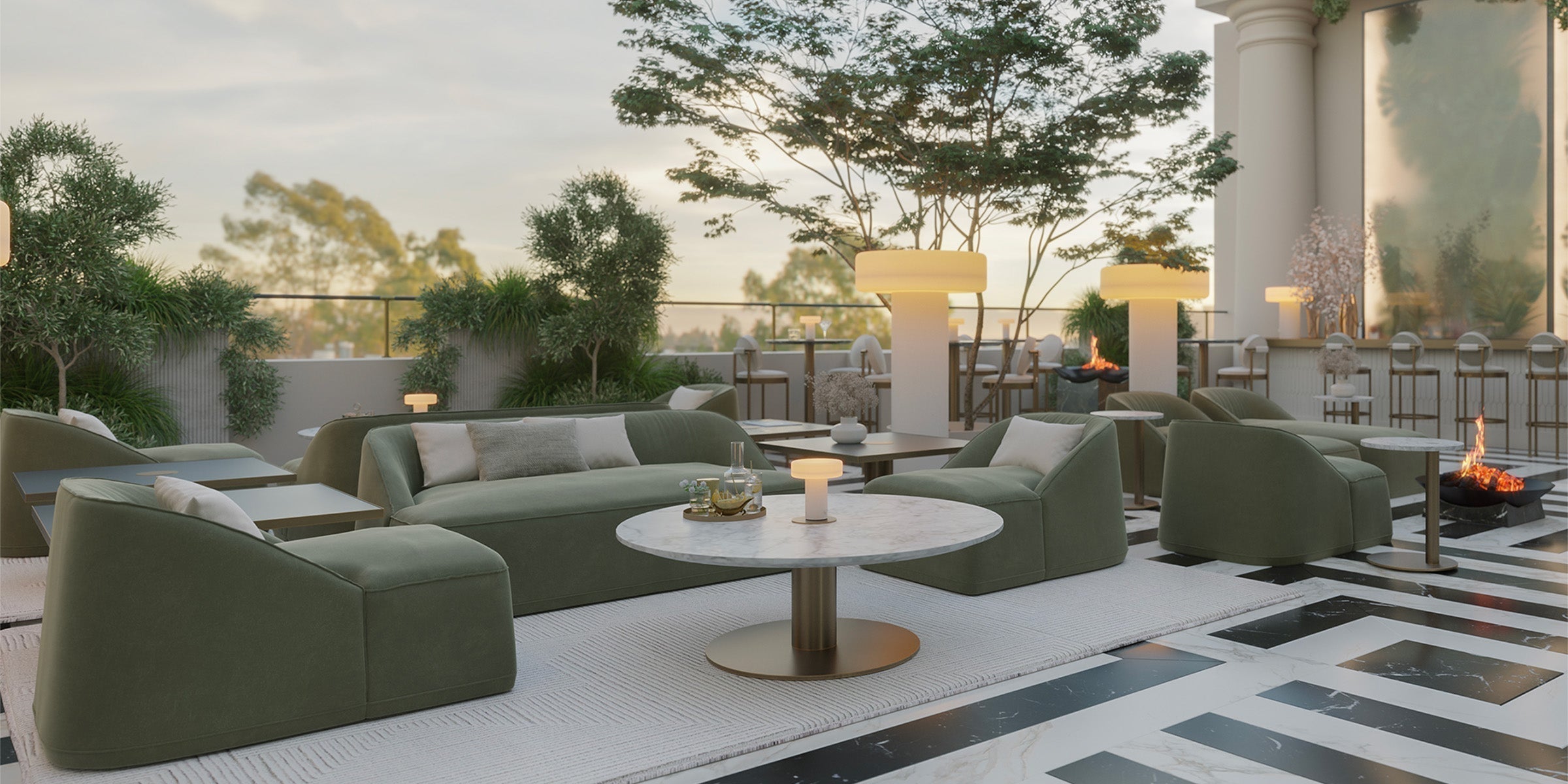Between UV rays, rain, frost, salt air and temperature fluctuations, the outdoors puts materials to the test. To choose durable outdoor furniture , this guide offers a simple grid: nature of materials ( powder-coated aluminum, 316 stainless steel, grade A teak, HPL, ceramic/sintered stone), quality of treatments (cataphoresis, powder coating), design (clean welding, stainless steel screws) and technical textiles (acrylic fabrics, quick-dry foams). You will discover the winning combinations depending on the environment, seaside, mountain or urban, as well as accessible maintenance routines to preserve aesthetics and performance season after season.
Resistance criteria to know
Before choosing an outdoor table, deckchair, or sofa, consider three key factors: the nature of the materials, the quality of the design and treatment, and the performance of the fabrics. These criteria determine the fabric's resistance to UV rays, water, salt, shocks, and temperature variations, and determine its durability and aesthetics throughout the seasons.
Resistant materials

Powder-coated aluminum offers excellent exterior resistance thanks to its inertness to corrosion and an oven-hardened powder coating that protects against UV rays and impacts. In aggressive environments (seaside, swimming pools), 304 stainless steel is acceptable, but 316 stainless steel , enriched with molybdenum, is much more resistant to chlorides. Grade A teak , dense and rich in natural oils, withstands humidity and temperature variations provided it is properly maintained. HPL (high-pressure compact laminate) tops and fronts combine dimensional stability, impact resistance and impermeability. UV-stabilized woven resin (HDPE) braids retain their color and do not disintegrate, while remaining easy to clean. Finally, ceramic and sintered stone resist scratches, stains and UV rays without warping or discoloring.
Design and treatments: what you need to know
Durability depends as much on the design as on the material: a cataphoretic treatment (e-coat) protects the inside of the tubes before powder coating, limiting under-film corrosion. Favor cleanly welded frames with drainage points, uniform powder coating, and A2/A4 stainless steel screws to avoid galvanic corrosion. Glued assemblies must use marine adhesives (PU or epoxy), and metal/wood interfaces must have spacers to limit rising damp. Suitable pads, screw covers, and good expansion management complete the package.
Technical textiles: our recommendations
A solution-dyed acrylic fabric (Sunbrella type) ensures excellent color fastness (7–8/8 to blue), good breathability and a permanently reactivatable water-repellent treatment. The open-cell quick-dry foam fillings wick away water quickly, limiting mold and odors. Check the fabric density (g/m²), water-repellent rating, abrasion resistance and the presence of removable covers with quality zippers to facilitate seasonal maintenance.
Comparison by environment
The choice of materials and treatments depends heavily on the exposure context. Here are the combinations that ensure the best resistance under specific constraints.
Seaside
Choose powder-coated aluminum structures with 316 stainless steel screws and fittings, which are more tolerant to chlorides and sea spray. For tabletops, HPL or ceramic limit saline attack and porosity. Choose electrically insulated assemblies (spacers, rings) to prevent galvanic corrosion, continuous welds with drainage points, and exterior polyester powder coating. For seats and cushions, solution-dyed acrylic fabrics and quick-drying foams make it easier to rinse with fresh water after exposure to salt.
Mountain or humid climate
Opt for dense woods like grade A teak, naturally rich in oils, combined with water-repellent protection (saturator) rather than film-forming varnishes. Metal frames must offer internal and external protection (cataphoresis then powder coating) with stainless steel screws and raised feet to limit rising damp. HPL or ceramic tops remain stable in the face of frost and high temperature variations. Choose removable cushions, open-cell foams and ventilation of the furniture during winter storage.
Urban or exposure to pollution
Cataphoresis-treated steel coated with a thick polyester powder coat resists impacts, micro-scratches, and pollutant deposits. Pair it with easy-to-clean HPL or compact laminate tops and stainless steel hardware. Lightly textured finishes better mask marks, while abrasion-resistant glides protect mineral floors. Regular maintenance (rinsing, neutral soap) prevents the formation of a polluting film that can retain moisture and accelerate oxidation.
Maintenance = longevity
The best resistance also comes from regular actions. Our article How to maintain a garden furniture set explains how to properly maintain your furniture. Then adopt a simple routine: rinse with clean water after salty or dusty episodes, monthly washing with neutral soap with a soft sponge, complete drying before replacing the covers, biannual check of the screws and pads. On wood (teak), use a saturator rather than a film-forming varnish; on powder-coated aluminum and treated steel, avoid a high-pressure cleaner; on HPL or ceramic, a microfiber cloth is sufficient, without aggressive solvents. As for textiles, vacuum regularly, remove stains with warm soapy water, reactivate the water repellency once a season and store the cushions in a dry and ventilated place.
- Breathable covers with vents, only placed on clean, dry furniture
- Pads adapted to the floor, replaced as soon as they wear out to avoid capillarity
- Slight elevation and clear drainage points to limit stagnant water
- End-of-season inspection, complete cleaning, sheltered storage for wintering
Choose wisely by typology
Beyond materials, adapt each piece to its actual use. A deckchair should prioritize ergonomics and breathability, while a table requires stability, tolerance to expansion, and an easy-to-maintain surface. Also consider consistent finishes and colors for a cohesive composition over time.
Deckchair
For a high-performance deckchair , look for a rigid and lightweight frame (powder-coated aluminum or carefully selected grade A teak), a multi-position backrest, discreet wheels for mobility, and replaceable glides. Choose breathable canvas or solution-dyed acrylic fabric covers with quick-drying foam, reinforced seams, and stainless steel fasteners suited to your environment. The ability to easily replace the canvas or cover extends its lifespan.
Outdoor tables

Outdoor tables are more durable with properly oiled HPL, ceramic, or teak tops mounted on a stable frame with adjustable feet to compensate for uneven floors. Ensure the top's mounting accommodates differential expansion between the base and the surface, and that the hardware is stainless steel. Protected edges, quality powder coating, and an easy-to-clean surface improve durability.
Consistency tip : Match the seats and table to the same family of finishes and materials. In addition to aesthetics, this reduces the need for galvanized pairs, facilitates maintenance using common products, and ensures uniform visual wear throughout.
Durable cushions
Comfort and durability depend largely on fabrics and fillings. Choose solution-dyed acrylic fabrics, strong seams, and quick-drying foams, then complement with a selection of outdoor cushions suited to your environment.
- Removable covers: zippered covers, corrosion-resistant closures, easy maintenance and replaceable parts.
- UV: mass-dyed fabric with high color fastness (7–8/8), reactivatable water-repellent treatment, resistance to chlorine and salt air.
- Quick drying: open-cell filling, drainage channels and air circulation to limit mold and odors.
- Storage: dry completely before covering, breathable bags and covers, dry and ventilated shelter, raised cushions off the ground.
The key is to choose a few simple and effective choices: select materials suited to your environment: seaside: powder-coated aluminum, 316 stainless steel and HPL or ceramic; humid climate: grade A teak with water-repellent protection; urban environment: treated steel and powder coating, prioritize careful design with clean welds and stainless steel hardware, then opt for solution-dyed acrylic textiles combined with quick-drying foams.
With reasonable maintenance (rinsing, gentle cleaning, breathable covers, dry storage) and a consistent range between seats and table, your furniture will retain its aesthetics and comfort season after season.





Leave a comment
All comments are moderated before being published.
This site is protected by hCaptcha and the hCaptcha Privacy Policy and Terms of Service apply.